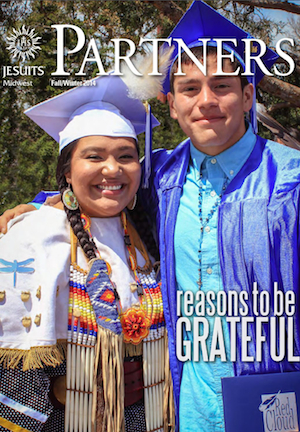Red Cloud Indian School Empowers Lakota
Originally published in Jesuit Partners Magazine
By Fr. George Winzenburg, S.J.
President of Red Cloud Indian School
 The big sky is the first thing you notice. The land is vast and winters can be harsh. No one travels when blizzards arise and snow is drifting. We are in South Dakota.
The big sky is the first thing you notice. The land is vast and winters can be harsh. No one travels when blizzards arise and snow is drifting. We are in South Dakota.
The Pine Ridge Indian Reservation is about the size of Connecticut. It is strikingly beautiful land with rolling hills and canyons, and close to the Badlands and the Black Hills. The Rez, as we call it, is home to more than 30,000 Lakota. It is the second poorest county in the United States. Per capita income is about $7,800.
Despite their suffering, Lakota are resilient. They are family-centered and spiritual. They are generous with their time and what little resources they have. They embrace values that can teach other Americans and people of the world what it means to be hospitable, respectful, and wise. They love to tease one another and know how to laugh.
There’s a young student at Red Cloud whom I sometimes see in class and at Sunday Mass. I have ridden one of our well-worn school buses early in the morning and watched her run from her trailer house, jump on the bus, and greet her friends. One day I asked Mia that dreaded question adults invariably ask students: “What do you want to be when you grow up?” Without hesitation she wrapped her arms around my waist, looked up at me with her beautiful brown eyes, and said, “I want to be a saint!”
You and I know too much about ourselves to think we are saints. But we are smart enough to know that children teach us to be humble, to keep our dreams alive, and to see sacredness in ourselves and in others, especially society’s poor and forgotten people.
Jesuits help to staff Red Cloud Indian School and six churches. Red Cloud exhibits Lakota art in its Heritage Center, and has 600 students in grades K–12. Last May, our valedictorian approached a podium dressed in a graduation gown with traditional Lakota regalia. She spoke in Lakota and then in English. She welcomed everyone with a warm handshake and said: “I am seventeen years old. I humbly take courage and seek knowledge and wisdom gratefully. I give thanks to my mother. She has shown me how to attain a good education. She is a courageous and strong-hearted woman.”
Savannah turned to her classmates and said: “Never take no for an answer, stay true to yourself, continue to persevere and keep your humility because you can do anything. My mother is my life and my example. With her and many of our role models paving the way, continue that path for the future generations because when you rise, we all rise.”
Savannah is now a freshman at Stanford University, where she has joined Red Cloud graduates from each of the last three years.
Red Cloud Indian School has been educating Lakota children since 1888. It is a beacon of hope for Lakota families through our schools and parishes. Come and visit us! You will meet beautiful children whose dreams will warm your heart and fill you with hope.
The History of the Red Cloud Indian School
The nation’s third smallest diocese by number of Catholics is the Diocese of Rapid City, which encompasses 43,000 square miles in western South Dakota and includes the Badlands and Mount Rushmore, popular destinations for visitors. It is home to Native Americans living on five reservations. Bound on the east by the Missouri River, the prairies of the diocese are scattered with farms and ranches and small towns. The Black Hills, the highest mountain range east of the Rocky Mountains, runs along the western edge of the diocese. There is a stark beauty to land in the West. It is rugged. It is also sacred.
Native Americans traveled the land for countless years before European immigrants arrived. The Lakota, Dakota, and Nakota were an alliance of friends who formed the largest indigenous population on the northern Plains of North America. They lived in harmony with the land and its animals, hunting bison and using every part of this magnificent creature to meet their needs for food, clothing, and tools. Native peoples saw the presence of the Great Spirit everywhere, especially in Paha Sapa, the Black Hills, where they spent the winter and practiced their sacred rites and ceremonies. The people believed they lived within a sacred circle, marked by changing seasons and the circle of birth, childhood, adulthood, and death. Family was the backbone of their culture and kinship was their connection to the world at large and everything within it.
Originally published in the Fall/Winter 2014 issue of Partners Magazine
Photos are Copyrighted ©Christopher Ives / Red Cloud Indian School
